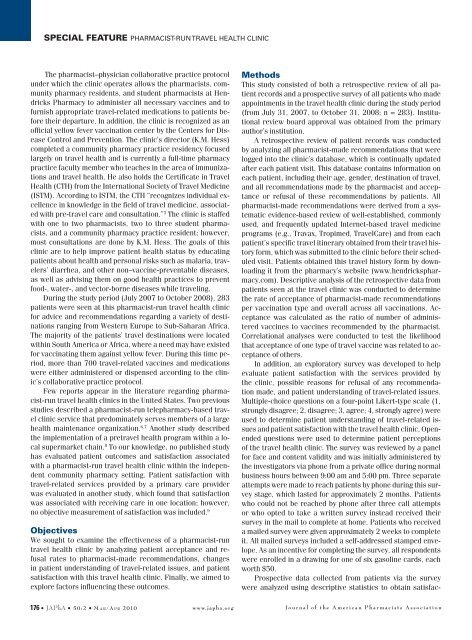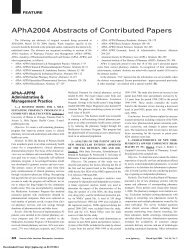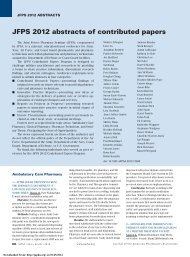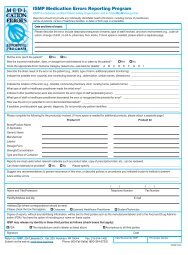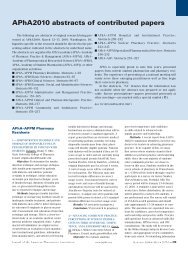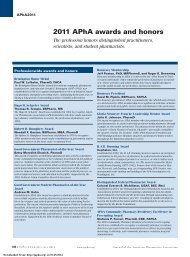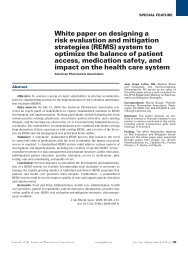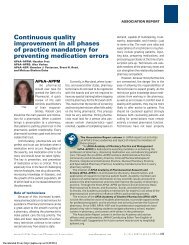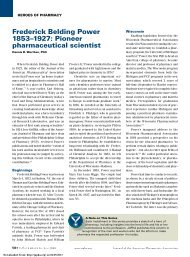Measuring outcomes of a pharmacist-run travel health clinic located ...
Measuring outcomes of a pharmacist-run travel health clinic located ...
Measuring outcomes of a pharmacist-run travel health clinic located ...
Create successful ePaper yourself
Turn your PDF publications into a flip-book with our unique Google optimized e-Paper software.
SPECIAL FEATURE PHARMACIST-RUn TRAvEL HEALTH CLInIC<br />
The <strong>pharmacist</strong>–physician collaborative practice protocol<br />
under which the <strong>clinic</strong> operates allows the <strong>pharmacist</strong>s, community<br />
pharmacy residents, and student <strong>pharmacist</strong>s at Hendricks<br />
Pharmacy to administer all necessary vaccines and to<br />
furnish appropriate <strong>travel</strong>-related medications to patients before<br />
their departure. In addition, the <strong>clinic</strong> is recognized as an<br />
<strong>of</strong>ficial yellow fever vaccination center by the Centers for Disease<br />
Control and Prevention. The <strong>clinic</strong>’s director (K.M. Hess)<br />
completed a community pharmacy practice residency focused<br />
largely on <strong>travel</strong> <strong>health</strong> and is currently a full-time pharmacy<br />
practice faculty member who teaches in the area <strong>of</strong> immunizations<br />
and <strong>travel</strong> <strong>health</strong>. He also holds the Certificate in Travel<br />
Health (CTH) from the International Society <strong>of</strong> Travel Medicine<br />
(ISTM). According to ISTM, the CTH “recognizes individual excellence<br />
in knowledge in the field <strong>of</strong> <strong>travel</strong> medicine, associated<br />
with pre-<strong>travel</strong> care and consultation.” 5 The <strong>clinic</strong> is staffed<br />
with one to two <strong>pharmacist</strong>s, two to three student <strong>pharmacist</strong>s,<br />
and a community pharmacy practice resident; however,<br />
most consultations are done by K.M. Hess. The goals <strong>of</strong> this<br />
<strong>clinic</strong> are to help improve patient <strong>health</strong> status by educating<br />
patients about <strong>health</strong> and personal risks such as malaria, <strong>travel</strong>ers’<br />
diarrhea, and other non–vaccine-preventable diseases,<br />
as well as advising them on good <strong>health</strong> practices to prevent<br />
food-, water-, and vector-borne diseases while <strong>travel</strong>ing.<br />
During the study period (July 2007 to October 2008), 283<br />
patients were seen at this <strong>pharmacist</strong>-<strong>run</strong> <strong>travel</strong> <strong>health</strong> <strong>clinic</strong><br />
for advice and recommendations regarding a variety <strong>of</strong> destinations<br />
ranging from Western Europe to Sub-Saharan Africa.<br />
The majority <strong>of</strong> the patients’ <strong>travel</strong> destinations were <strong>located</strong><br />
within South America or Africa, where a need may have existed<br />
for vaccinating them against yellow fever. During this time period,<br />
more than 700 <strong>travel</strong>-related vaccines and medications<br />
were either administered or dispensed according to the <strong>clinic</strong>’s<br />
collaborative practice protocol.<br />
Few reports appear in the literature regarding <strong>pharmacist</strong>-<strong>run</strong><br />
<strong>travel</strong> <strong>health</strong> <strong>clinic</strong>s in the United States. Two previous<br />
studies described a <strong>pharmacist</strong>-<strong>run</strong> telepharmacy-based <strong>travel</strong><br />
<strong>clinic</strong> service that predominately serves members <strong>of</strong> a large<br />
<strong>health</strong> maintenance organization. 6,7 Another study described<br />
the implementation <strong>of</strong> a pre<strong>travel</strong> <strong>health</strong> program within a local<br />
supermarket chain. 8 To our knowledge, no published study<br />
has evaluated patient <strong>outcomes</strong> and satisfaction associated<br />
with a <strong>pharmacist</strong>-<strong>run</strong> <strong>travel</strong> <strong>health</strong> <strong>clinic</strong> within the independent<br />
community pharmacy setting. Patient satisfaction with<br />
<strong>travel</strong>-related services provided by a primary care provider<br />
was evaluated in another study, which found that satisfaction<br />
was associated with receiving care in one location; however,<br />
no objective measurement <strong>of</strong> satisfaction was included. 9<br />
Objectives<br />
We sought to examine the effectiveness <strong>of</strong> a <strong>pharmacist</strong>-<strong>run</strong><br />
<strong>travel</strong> <strong>health</strong> <strong>clinic</strong> by analyzing patient acceptance and refusal<br />
rates to <strong>pharmacist</strong>-made recommendations, changes<br />
in patient understanding <strong>of</strong> <strong>travel</strong>-related issues, and patient<br />
satisfaction with this <strong>travel</strong> <strong>health</strong> <strong>clinic</strong>. Finally, we aimed to<br />
explore factors influencing these <strong>outcomes</strong>.<br />
176 • JAPhA • 50:2 • M a r/apr 2010<br />
www.japha.org<br />
Methods<br />
This study consisted <strong>of</strong> both a retrospective review <strong>of</strong> all patient<br />
records and a prospective survey <strong>of</strong> all patients who made<br />
appointments in the <strong>travel</strong> <strong>health</strong> <strong>clinic</strong> during the study period<br />
(from July 31, 2007, to October 31, 2008; n = 283). Institutional<br />
review board approval was obtained from the primary<br />
author’s institution.<br />
A retrospective review <strong>of</strong> patient records was conducted<br />
by analyzing all <strong>pharmacist</strong>-made recommendations that were<br />
logged into the <strong>clinic</strong>’s database, which is continually updated<br />
after each patient visit. This database contains information on<br />
each patient, including their age, gender, destination <strong>of</strong> <strong>travel</strong>,<br />
and all recommendations made by the <strong>pharmacist</strong> and acceptance<br />
or refusal <strong>of</strong> these recommendations by patients. All<br />
<strong>pharmacist</strong>-made recommendations were derived from a systematic<br />
evidence-based review <strong>of</strong> well-established, commonly<br />
used, and frequently updated Internet-based <strong>travel</strong> medicine<br />
programs (e.g., Travax, Tropimed, TravelCare) and from each<br />
patient’s specific <strong>travel</strong> itinerary obtained from their <strong>travel</strong> history<br />
form, which was submitted to the <strong>clinic</strong> before their scheduled<br />
visit. Patients obtained this <strong>travel</strong> history form by downloading<br />
it from the pharmacy’s website (www.hendrickspharmacy.com).<br />
Descriptive analysis <strong>of</strong> the retrospective data from<br />
patients seen at the <strong>travel</strong> <strong>clinic</strong> was conducted to determine<br />
the rate <strong>of</strong> acceptance <strong>of</strong> <strong>pharmacist</strong>-made recommendations<br />
per vaccination type and overall across all vaccinations. Acceptance<br />
was calculated as the ratio <strong>of</strong> number <strong>of</strong> administered<br />
vaccines to vaccines recommended by the <strong>pharmacist</strong>.<br />
Correlational analyses were conducted to test the likelihood<br />
that acceptance <strong>of</strong> one type <strong>of</strong> <strong>travel</strong> vaccine was related to acceptance<br />
<strong>of</strong> others.<br />
In addition, an exploratory survey was developed to help<br />
evaluate patient satisfaction with the services provided by<br />
the <strong>clinic</strong>, possible reasons for refusal <strong>of</strong> any recommendation<br />
made, and patient understanding <strong>of</strong> <strong>travel</strong>-related issues.<br />
Multiple-choice questions on a four-point Likert-type scale (1,<br />
strongly disagree; 2, disagree; 3, agree; 4, strongly agree) were<br />
used to determine patient understanding <strong>of</strong> <strong>travel</strong>-related issues<br />
and patient satisfaction with the <strong>travel</strong> <strong>health</strong> <strong>clinic</strong>. Openended<br />
questions were used to determine patient perceptions<br />
<strong>of</strong> the <strong>travel</strong> <strong>health</strong> <strong>clinic</strong>. The survey was reviewed by a panel<br />
for face and content validity and was initially administered by<br />
the investigators via phone from a private <strong>of</strong>fice during normal<br />
business hours between 9:00 am and 5:00 pm. Three separate<br />
attempts were made to reach patients by phone during this survey<br />
stage, which lasted for approximately 2 months. Patients<br />
who could not be reached by phone after three call attempts<br />
or who opted to take a written survey instead received their<br />
survey in the mail to complete at home. Patients who received<br />
a mailed survey were given approximately 2 weeks to complete<br />
it. All mailed surveys included a self-addressed stamped envelope.<br />
As an incentive for completing the survey, all respondents<br />
were enrolled in a drawing for one <strong>of</strong> six gasoline cards, each<br />
worth $50.<br />
Prospective data collected from patients via the survey<br />
were analyzed using descriptive statistics to obtain satisfac-<br />
J o u r n a l o f t h e A m e r i c a n P h a r m a c i s t s A s s o c i a t i o n<br />
176 3/1/10 12:49 PM


